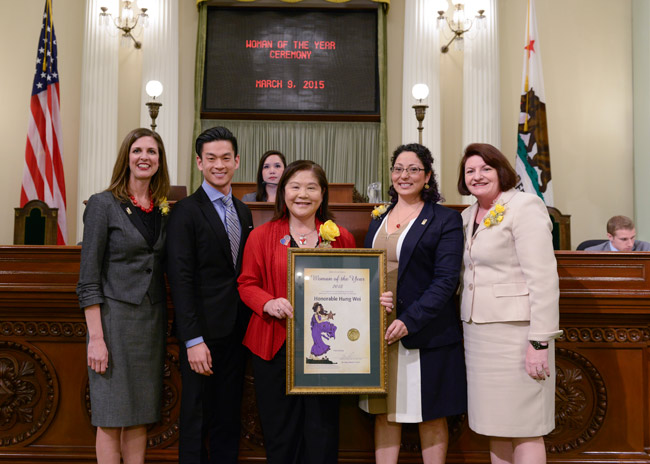Each March, during "National Women's History Month," we acknowledge the accomplishments and contributions of those who helped improve the status of women in America. Today's woman is the living legacy of equal rights achieved non-violently and against all odds by those who, at the time, were so powerless. There is, however, much more left to be done.
Unfortunately, many of us remember when women were thought of only as mothers, sisters and wives. Over the last few decades, however, during the rise of a monumental women's movement, women have finally gained well-deserved recognition for their many contributions to society. Today, women are the doctors who save our lives and the educators who teach our children. They are attorneys, pilots, engineers, and soldiers. They are the police who enforce the laws and the legislators who make them.
Interestingly, there will be fewer women serving in State Legislatures in 2015, although the number still serves as a four-fold increase since 1971. Approximately, 1,750 state legislators will be women, compared to approximately 1, 784 last year. This is a decrease to 23.7 percent from 24.2 percent in 2014.
The California Legislative Women's Caucus was formed in 1985 by nine Democrats and six Republicans. According to its by-laws, the purpose of the caucus is to "encourage collegiality, participation in and cooperation among elected women in California government and to promote the interests of women, children and families through legislation."
Today, there are 31 women members of the California Legislature. While California has a bit less women in the Legislature this session, they have more in leadership positions, including the second woman Speaker of the California State Assembly, Toni G. Atkins.
From these humble beginnings, the progress forward is undeniable. But even with the strides made by female elected officials, it is important to remember that this work can be undone if we are not vigilant and actively encourage women to seek elective office.

Congratulations to the Honorable Hung Wei (President of Cupertino Rotary and Governing Board Member of the Fremont Union High School District) on being honored as Woman of the Year for Assembly District 28-Silicon Valley. In recognition of March as Women's History Month, the state legislature recognizes the leadership of women in California.
Milestones in California History as it Relates to Women’s Issues
1878: California Statute that banned women from practicing law in the state is repealed.
1911: In a massive campaign, women gain the vote in California by an average margin of one
vote per precinct.
1965: Governor Pat Brown establishes the California Commission on the Status of Women as an
Advisory Commission; the Commission is made permanent in 1971 under Governor Ronald
Reagan.
1970: No Fault Divorce is enacted in California.
1973: The California Legislature ratifies adding an Equal Rights Amendment to the United
States Constitution.
1974 Federal Women’s Education Equity Act enacted.
1977 Title IX of the Federal Education Code enacted.
1981: One of the first equal pay for equal work measures in the nation is introduced in the
California State Legislature.
1987: The United States Supreme Court upholds a California law from 1978, which allows
women up to four months unpaid leave for a disabling pregnancy.
1992: California becomes the first state to elect two women United States Senators.
2009: President Obama signs Ledbetter Fair Pay Act.
2010: AB 113 signed into law (Portantino) removes the age-based utilization of mammograms
contained in the Insurance Code.
2010: AB 1800 signed into law (Skinner) requires that pregnant women, when they are inmates
or wards, be retrained in the least restrictive way possible and only when restraints are necessary.
2010: AB 2364 signed into law (Nava) permits the Employment Development Department to
award unemployment insurance benefits to workers who leave their jobs to protect family
members from domestic violence.
2010: AB 2468 signed into law (De Leon) authorizes employers to use the designation “BreastFeeding
Mother Friendly Workplace” if the employer’s policy meets certain criteria to address
the needs of breast-feeding mothers.
2010: SB 1233 signed into law (Oropeza), removes the sunset provision for the Secretary of
State’s Safe At Home address confidentiality program for victims of domestic violence, sexual
assault, or stalking, and requires that the name change records for program participants be
permanently retained.
2011 AB 454 signed into law (Silva), requires a court to deny early termination of a protective
order, if the party that has requested the protective order has not been notified of the request for
early termination.
2011 AB 620 signed into law (Block) requests the Trustees of the California State University, the
Regents of the University of California and the governing boards of each community college
district to adopt and publish policies on harassment, intimidation, and bullying to be included
within the rules of student conduct governing their respective segments of public postsecondary
education.
2011 AB 1156 signed into law (Eng) encourages the inclusion of policies and procedures aimed
at the prevention of bullying, including gender based bullying, in comprehensive school safety
plans.
2012: AB 2348 signed into law (Mitchell) allows registered nurses to administer and disperse
hormonal contraceptives and to help with midwife procedures.
2012 AB 137 signed into law (Portantino) requires health insurance policies to cover
mammograms.
2013 AB 154 signed into law (Atkins) authorizes nurses, certain midwives and physician
assistance to provide first trimester aspiration abortion care.
2013 AB 161 signed into law (Campos) provides additional economic and financial safeguards
for domestic violence victims.
2013 SB 400 signed into law (Jackson) protects the employment rights of victims of domestic
violence, sexual assault and stalking and requires the employer to provide them with reasonable
workplace accomodations.
2013 AB 65 (Achadjian) & SB 59 (Evans) closes a rape “loophole” by clarifying that someone
who induces a victim into sexual activity by impersonating someone else that is known to the
victim can be charged with felony rape.
